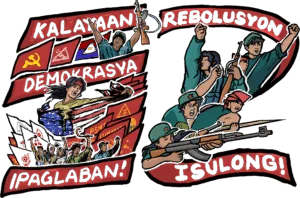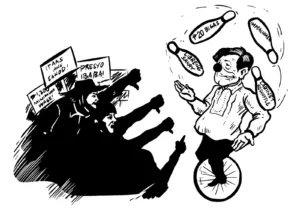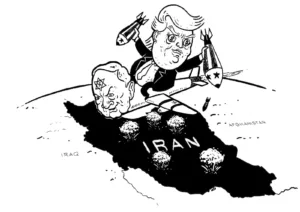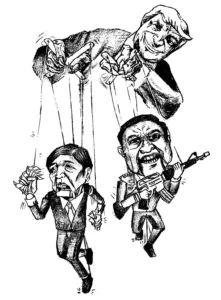Contribution to the 18th International Communist Seminar (Brussels)
By Communist Party of the Philippines
It is of constant decisive importance that a communist or workers' party and its youth organization arouse, organize and mobilize the broad masses of the youth in accordance with the general political line of the revolutionary movement of the proletariat and the people in various countries.
By youth, we mean the young workers and other working people, the young of the middle social strata, the students of secondary, tertiary and graduate levels and the young professionals. Their age ranges from 12 to 35. In any society, they comprise the majority of the population. Of all age groups, they are the most energetic and the most receptive to progressive ideas.
There is always a need for communists to do educational, organizational and mobilization work among the youth because that is the way to maintain the vitality, increase the strength and ensure the continuity of the revolutionary mass movement and the revolutionary party of the proletariat.
In the face of the grave situation brought about by the worst global financial and economic crisis since the Great Depression, the need is greater and more acute than ever for arousing, organizing and mobilizing the youth. They are severely affected by the ever worsening and deepening crisis. They are eager to join the mass actions in order to protest and make demands.
I. Current crisis situation
For more than three decades the monopoly bourgeoisie has escalated the exploitation and oppression of the proletariat and people of the world under the policy of "neoliberal globalization". This policy propagates the myth and dogma of the "free market". It gives free rein to the monopoly bourgeoisie in accelerating profit-taking from the working class and the oppressed peoples and nations, and the accumulation and concentration of capital in the US and other imperialist countries.
Under the policy, the working class and government social spending are blamed for the tendency of monopoly capitalism to stagnate and have inflation. The imperialists in their own home grounds and abroad have pushed down the wage and income levels of the people, eroded hard-won social benefits and curtailed the democratic rights of the people. But pressing down the incomes of the working people results in dwindling market demand and causing the crisis of overproduction.
In a futile attempt to overcome the crisis of overproduction and the tendency of the profit rate to fall upon the expansion of capitalist production, the monopoly bourgeoisie has removed national restrictions to investment and trade, and has denationalized the economies of underdeveloped countries. It has privatized public resources in order to enlarge private capital and facilitate profit-taking. It has removed regulations that protect public interest, labor, women, children and the ecology.
On top of everything, it has deregulated debt financing and the creation of fictitious capital and financial bubbles in order to cover deficits and conjure the illusion of constant growth. But it is exactly in the stratosphere of monopoly finance capitalism where the system is broken. The worst financial crisis since the Great Depression has broken out and and has cascaded and crashed into the real economy, causing reduced production and plant shutdowns; massive unemployment; loss of incomes and savings, disappearance of social benefits and pension funds, homelessness, lack of health protection and other forms of social catastrophe, especially for the working people and the youth.
The overwhelming majority of youth in the US and other imperialist countries are now in a dire situation. Those of school age suffer the deprivations and other adverse consequences that result from the loss of jobs by their parents. Those of working age, including those with vocational and professional training, are faced with the problems of no job opportunities at the outset, reduced pay for beginners or the constant danger of being laid off because of continued worsening and deepening of the crisis.
To be of working age and yet have no work or have some work but without adequate pay is a big disaster and means a miserable existence in an industrial capitalist country. The economic misery is compounded with a deep sense of injustice in view of the imperialist state's callous disregard for the interests of the working class and the youth and the bailouts given by the imperialist state to the monopoly bourgeoisie, especially the financial oligarchy, which is responsible for the crisis.
In industrial capitalist countries, the youth of foreign ancestry and those from migrant families suffer increased levels of national, ethnic, racial or religious discrimination from the state institutions, corporations and benighted groups of the majority population. The discrimination is manifested in public places, in schools and in the work place. The monopoly bourgeoisie uses various forms of discrimination in order to deflect attention from the roots of the crisis and divide the ranks of the working class and the youth.
The youth in the underdeveloped countries have long suffered the worst of economic and social conditions in the world. The overwhelming majority of their countries are dependent on raw material production for export and only a few have some manufactures and semi-manufactures for export. They are chronically in deficit and in need of foreign credit.
They are now in a terrible situation as orders for their exports have drastically fallen and international credit has tightened. Even the so-called emerging markets, previously privileged with large orders of semi-manufactures and heavy inflows of capital from the imperialist countries are now in serious trouble. The rate of unemployment is rapidly rising in agriculture, industry and the service sector. There is no social safety net for the old stock of unemployed as well as for the newly unemployed.
Under these conditions, the youth suffer more than ever before extreme conditions of deprivation, exploitation and oppression. The school population is decreasing. The reactionary states are in no position to expand the public school system and enable the children of workers and peasants to attend school. The impoverished families now wish their school age children to work and augment family income. But the jobs in both the formal and informal sectors of the economy have become scarce.
The youth in both industrial capitalist and underdeveloped countries are now under the heavy pressure of the global financial and economic crisis. They react to and reflect on the deteriorating conditions of their sector, their families and society in general. They strive to make the best possible out a dire situation in order to study or work within the system. An increasing number of them question why there is a crisis that brings so much misery and suffering to the people and consider how the social system can be improved through basic reforms or replaced with a better and just one through revolution. If systematically and properly approached by the communists, they welcome revolutionary ideas and are willing to become activists in the youth movement
Some of the youth become juvenile delinquents or even criminals as they see no decent work opportunity, their parents lose their jobs and their families crack up under the strain of the crisis. As the crisis prolongs and worsens, such youth can increase in number and become the lumpen proletariat, with anti-social propensities and vulnerable to manipulation by the monopoly bourgeoisie and its political agents. But if the revolutionary movement of the youth advances fast enough, it can directly and indirectly juvenile delinquency or criminality.
II. What to do among the youth
It is necessary to know the basic conditions of a country and the extent of the systemic crisis in order to carry out the general line of the revolutionary struggle of the broad masses of the people. To be most effective in work among the youth, it is necessary to do further social research and investigation among them in order to find out and learn from them what are their conditions, needs and demands, who among them can be developed as activists in the youth movement and what are the ways of arousing, organizing and mobilizing the youth.
Let us assume that the communist or workers' party recognizes the crucial importance of the youth movement and has young cadres for building the communist youth league and the youth movement as a mass movement. These young cadres should make contacts with their fellow youth in work places, communities, schools, club houses and other places where there are plenty of youth in order to hold meetings for making friends and doing social investigation. Such meetings may be attended by anywhere from five to twenty young people and may be facilitated by groups or individuals that priorly exist in the place.
The initial meetings are small because there are not yet many youth known in the place to be interested in the building of a progressive mass organization of youth and because there is an advantage in having ample time for everyone to participate in the discussion and learn from it. Consequent to raising the level of their political consciousness and recognizing the need for organizing the youth, the participants in the initial meetings can draw more youth to attend study meetings as well as general meetings on burning issues of the youth and the people.
The mass activists who are discovered and developed by the young communist cadres through social investigation, study meetings and mass actions must recognize the need to go beyond their initial small number and arouse the broad masses of the youth in their hundreds, then in their thousands and further on in bigger numbers. Mass actions of protest and demands must be undertaken as means of propaganda and agitation to arouse the youth in great numbers.
Before, during and after such mass actions, there are many forms of propaganda and education that must be done. These include publications, speeches , information or study meetings, wall slogans and posters, cultural performances and so on. Those who are most active in preparing, conducting and following up the mass actions must be encouraged to reach higher levels of consciousness and militancy through the systematic study of the society and revolution. They comprise the advanced section of the youth mass movement and the most advanced among them can be drawn to the young communist league or its equivalent and provided with Marxist-Leninist education.
There are two levels of organizing the youth. The basic level is the mass organization of the youth. For that purpose, there may be a comprehensive inter-class youth organization and there may also be sectoral, issue-based and territorial youth organizations. The higher level is organizing the youth as a communist youth league or its equivalent. It draws membership mainly from the youth mass movement. The communist youth movement cannot grow without the expansion of the youth mass movement in the arena of legal struggle.
The young communists and progressive youth activists must give the highest priority to organizing the youth of the working people, especially the workers in a developed capitalist country and the workers and peasants in an underdeveloped country. They should also exert all efforts to organize the students because these have the tendency to accept progressive ideas and act militantly. The young professionals and the intelligentsia must be organized so that they veer away from the exploiting class to the side of the working people.
In a reactionary political system, it is understandable that the communist youth league or its equivalent is underground. Even when it is possible for such league to exist legally in a reactionary political system, it must still be prudent to have a large part of it clandestine so that it cannot be totally destroyed under conditions of extreme repression. Of course, in a socialist society, the communist youth league exists and operates openly in training and developing its members to become full-fledged members of the ruling communist or workers' party.
The young communists and the activists of the progressive youth movement must appeal directly to the broad masses of youth and mobilize them in large numbers through campaigns on long-term as well as burning issues involving the rights and interests of the youth. But they must also engage in alliances with other youth organizations in order to augment the strength of the progressive youth and facilitate the mobilization of the youth in their millions on a nationwide scale.
By maintaining their initiative and independence, the communist and progressive youth organizations can avail of advantages in alliances and yet are not compromised to the extent that they veer away from their course of progressive reforms or social revolution. They must develop their own leadership and mass strength through the mass campaigns by reaching and inspiring the youth in great numbers, attracting them to join the progressive youth organizations and generating ever greater mass mobilizations of the youth.
The youth have their rights and interests distinct from those of the broad masses of the people. But they must not separate themselves from the people in the common struggle for greater freedom, democracy, social justice, all-around development and world peace. The communist and progressive youth movement can grow in strength and advance only by uniting, cooperating and coordinating with the exploited and oppressed people who fight for national liberation, democracy and socialism against imperialism and all reaction.
Conclusion: Prospects of the youth movement
The current grave socio-economic and political crisis of the world capitalist system has been in the making for many decades, at least three if we use as point of reference the US-instigated policy of "neoliberal globalization". This policy is totally bankrupt and has brought about the worst global financial and economic crisis since the Great Depression. It is wreaking havoc on the lives of the people throughout the world and yet the dogma of the "free market" or the neoliberal bias drives the imperialist powers to bail out the financial oligarchy at the continuing and increasing expense of the people.
The current grave crisis is still deepening and worsening and is likely to run for more than a decade. That is too long a time of suffering for the people. The youth and the people are impelled by the crisis to resist the exploiters and oppressors. There is ample time for the communist and progressive forces of the youth and the people to grow in strength and advance. The conditions of prolonged and deepgoing crisis are ultimately favorable for the resurgence and advance of the revolutionary movements of the youth and the people.










